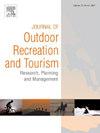Wayfinding and navigation behaviours among pilgrim tourists on the St. Olav Ways in Norway
IF 4.4
3区 管理学
Q1 HOSPITALITY, LEISURE, SPORT & TOURISM
Journal of Outdoor Recreation and Tourism-Research Planning and Management
Pub Date : 2025-05-27
DOI:10.1016/j.jort.2025.100891
引用次数: 0
Abstract
Pilgrim tourism is part of a sector of “slow,” cultural, religious and heritage-based tourism which is seen as desirable in the aftermath of the Covid-19 pandemic due to the potential psycho-physical transformational benefits. In this paper we analyse wayfinding and navigation behaviours among pilgrim tourists along the St. Olav Ways pilgrim paths in Norway. The pilgrim paths in themselves, with varying levels of physical signage and markings together with a growing database of digital markings, paths and maps, constitute a system of information for wayfinding (i.e. a “wayfinding system”). This information is relevant for the users in different parts of their journeys ranging from the planning phases, under ways along the paths, and to possible sharing of experiences after the journey is completed. Through a mixed methods approach with qualitative and quantitative data we have studied the case of wayfinding and applicable navigation information and behaviours along the pilgrim paths. We describe and analyse markings, signage, and digital tools using theoretical frameworks (Lynch 1960; Mollerup 2005; Wiener, Büchner, and Hölscher 2009; Barker 2019) to study wayfinding strategies and behaviours. What we describe as a wayfinding system is pivotal in the constitution and identity of the paths as pilgrim paths. Our research draws on observations, interviews, digital ethnography, and surveys to understand travellers’ motivations, information sources, and actions along the St. Olav Ways. From this we establish an empirically based description of wayfinding behaviours and preferences in the context of pilgrim tourism. The systematic description of the relevant official information of the St. Olav Ways as a wayfinding system, serves as a “best practice” for designing pilgrim or general-purpose hiking paths. Insights into pilgrim tourists' wayfinding behaviours can be used to guide the design, branding, communication, implementation, and management of such paths.
挪威圣奥拉夫路朝圣游客的寻路和导航行为
朝圣者旅游是“慢节奏”文化、宗教和遗产旅游的一部分,在2019冠状病毒病大流行之后,由于潜在的心理和身体转变效益,这种旅游被视为可取的。在本文中,我们分析了沿圣奥拉夫朝圣路径在挪威朝圣游客的寻路和导航行为。朝圣之路本身,加上不同层次的物理标志和标记,以及不断增长的数字标记、路径和地图数据库,构成了一个寻路信息系统(即“寻路系统”)。这些信息与用户在其旅程的不同阶段相关,从规划阶段,沿着路径的道路,到旅程完成后可能的经验分享。通过定性和定量数据的混合方法,我们研究了寻路和适用的导航信息以及朝圣者路径上的行为。我们使用理论框架描述和分析标记、标牌和数字工具(Lynch 1960;Mollerup 2005;Wiener, b chner, and Hölscher 2009;Barker 2019)研究寻路策略和行为。我们所描述的寻路系统在朝圣路径的构成和身份中起着关键作用。我们的研究通过观察、访谈、数字人种学和调查来了解游客的动机、信息来源和圣奥拉夫之路沿线的行为。由此,我们建立了基于经验的朝圣旅游背景下寻路行为和偏好的描述。系统地描述了圣奥拉夫道路作为寻路系统的相关官方信息,作为设计朝圣或一般用途徒步旅行路径的“最佳实践”。对朝圣游客寻路行为的洞察可以用来指导这些路径的设计、品牌、沟通、实施和管理。
本文章由计算机程序翻译,如有差异,请以英文原文为准。
求助全文
约1分钟内获得全文
求助全文
来源期刊

Journal of Outdoor Recreation and Tourism-Research Planning and Management
HOSPITALITY, LEISURE, SPORT & TOURISM-
CiteScore
6.70
自引率
5.30%
发文量
84
期刊介绍:
Journal of Outdoor Recreation and Tourism offers a dedicated outlet for research relevant to social sciences and natural resources. The journal publishes peer reviewed original research on all aspects of outdoor recreation planning and management, covering the entire spectrum of settings from wilderness to urban outdoor recreation opportunities. It also focuses on new products and findings in nature based tourism and park management. JORT is an interdisciplinary and transdisciplinary journal, articles may focus on any aspect of theory, method, or concept of outdoor recreation research, planning or management, and interdisciplinary work is especially welcome, and may be of a theoretical and/or a case study nature. Depending on the topic of investigation, articles may be positioned within one academic discipline, or draw from several disciplines in an integrative manner, with overarching relevance to social sciences and natural resources. JORT is international in scope and attracts scholars from all reaches of the world to facilitate the exchange of ideas. As such, the journal enhances understanding of scientific knowledge, empirical results, and practitioners'' needs. Therefore in JORT each article is accompanied by an executive summary, written by the editors or authors, highlighting the planning and management relevant aspects of the article.
 求助内容:
求助内容: 应助结果提醒方式:
应助结果提醒方式:


